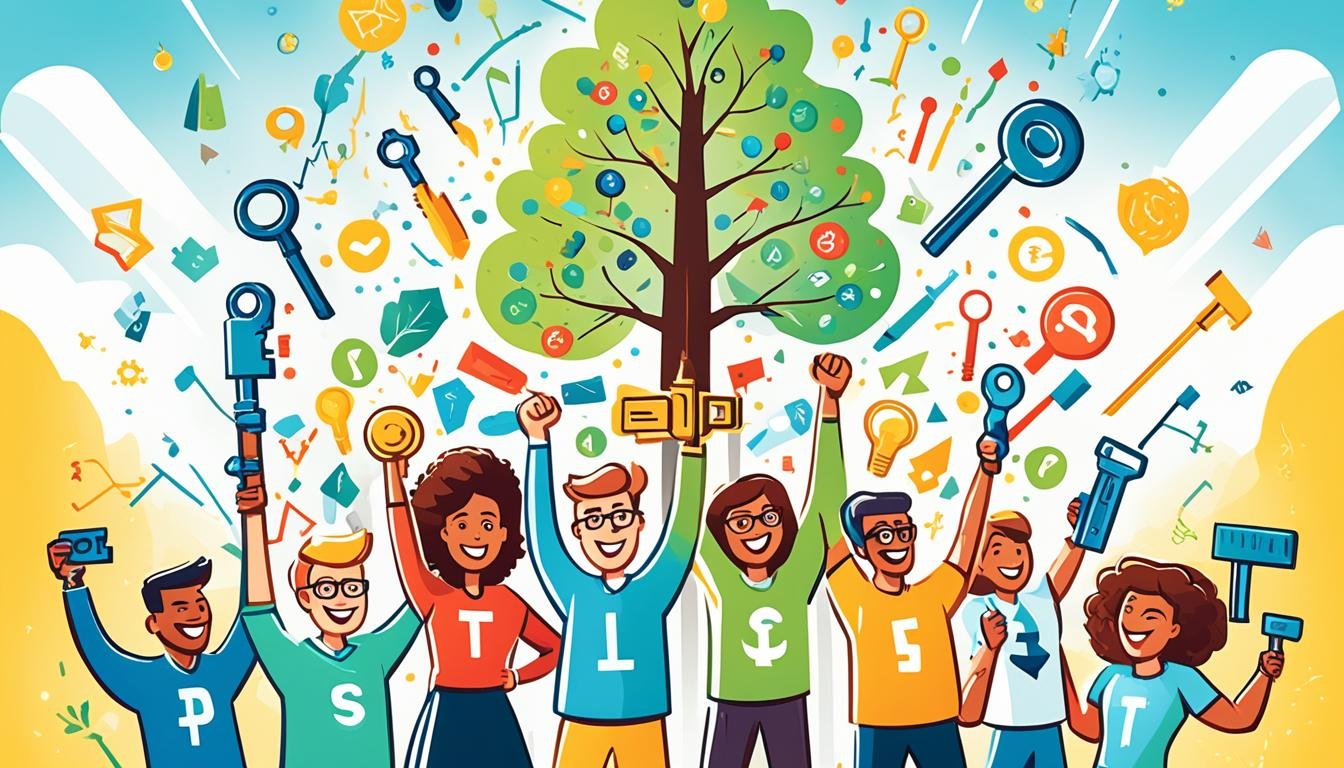Leadership in Human Resources: Empowering Talent
“The function of leadership is to produce more leaders, not more followers.” – Ralph Nader
Today’s business world requires a new approach to HR leadership. We’ve moved past cost-cutting and rigid HR practices. A new era is born, focusing on encouraging talent and welcoming creativity and change. This shift is more pronounced now due to the COVID-19 outbreak.
COVID-19 has fast-tracked the need to think differently in HR. With remote work and hybrid models on the rise, CHROs are finding fresh ways to connect and build trust with employees. As a result, modern HR leadership is all about engaging and empowering staff.
Our exploration will cover crucial parts of today’s HR leadership. We’ll look at how to nurture talent, increase engagement, and smoothly guide through changes in the company. Topics will range from boosting diversity and including all to ensuring the well-being of the workforce. HR leaders play a key role in defining the future of work.
Key Takeaways:
- HR leadership is shifting towards empowering talent and embracing creativity and innovation.
- The COVID-19 pandemic has accelerated the adoption of agile HR models and raised concerns about the future of hybrid work.
- Engaging directly with employees and building a culture of trust are key priorities for HR leaders.
- Emphasizing employee well-being and championing diversity and inclusion contribute to a thriving work environment.
- Strong HR leadership is essential in managing organizational transitions and fostering sustainable growth.
Engaging More Directly and Deeply with Employees
Today, European CHROs are seeing how vital it is to connect directly and deeply with workers. Especially true in the hybrid work era, standard help-yourself tools might not be enough. Focusing on personal or face-to-face talks, they are moving beyond the usual methods to strengthen ties.
When companies really talk to their workers, everyone wins. This kind of direct involvement boosts team spirit and helps work go better. People feel they really matter and fit in, motivating them to be more committed.
Negotiations, starting a new job, coming up with new ideas, and coaching are all key chances for managers to connect with their team. This personal touch and tailored help give employees the push they need to do well.
Workforce Segmentation: Unlocking Untapped Potential
Segmenting the workforce helps CHROs see what makes each worker special. It’s not just about age or job title, but about who they are, what they dream of, and what they’ve learned. With this approach, companies can create plans that really speak to each worker’s future, growth, and performance.
Also, using strong surveys is key to keeping an eye on how the company is doing. Feedback from these surveys tells us if our ideas to keep employees happy are working or not. These insights help us do better in making our plans.
To truly connect with employees, we have to step away from the same old methods. Now, it’s about being personal and knowing what makes each worker tick. This is how we create real bonds and an engaging work environment.
“Engaging with employees on a deeper level enables organizations to tap into their full potential. By understanding their unique needs and aspirations, we can create an environment where every employee thrives.” – Sarah Thompson, Chief Human Resources Officer at XYZ Company
Building strong relationships is key to getting employees more involved. By using personalized talks and knowing each individual’s strengths, organizations can become places where everyone feels seen and heard.
Letting Employees Bring Their Whole Person to Work
Today, HR leaders understand the need to look at how we treat our employees differently. They see that it’s not enough to just manage talent and skills. Now, the goal is to build a workplace that’s welcoming to all, emphasizes the skills of understanding others, cares for each individual, and values good communication.
Now, making sure employees have a great time at work is a priority. This means welcoming everyone as they are by valuing different backgrounds and ideas. It also means making sure everyone feels like they belong and respect each other.
“Diversity is being invited to the party; inclusion is being asked to dance.”
HR is working hard to make work environments where people understand each other and are kind. They’ve realized that emotional understanding is key. It makes people work together better and solve problems faster. When people feel understood and cared for, everything just works better.
HR cares a lot about making sure people are healthy and happy. They offer programs to help with mental and physical health and balance work with personal life. By looking after the well-being of employees, HR boosts how happy people are with their jobs.
Being good at talking and listening is crucial in HR. They use different ways to share company goals and guide everyone in the same direction. When we talk openly and clearly, businesses become like big families. Everyone trusts each other, works together well, and reaches success together.
Paving the Way to the New Possible
HR leaders guide their teams through big changes. They help everyone make quick and smart choices. With their strategies, they build a culture of strong, innovative minds.
Being able to make fast decisions is key. HR leaders teach their teams how to react fast. This helps the whole company keep up and do well.
During changes, HR leaders focus on helping everyone adjust. They listen to worries and make sure there’s clear direction. This keeps the team together.
Helping employees grow is a top goal for HR. They give tools and support to unlock hidden talents. This way, each person can do their best and help the company succeed.
“Empowered employees are more likely to think critically, propose innovative ideas, and make decisions aligned with the organization’s goals.”
Building talent is key to creating new paths. HR invests in making sure everyone has the right skills. This helps the company grow and be successful.
Transition times bring both hard times and chances to succeed. HR helps make a culture where change is welcomed. This supports everyone to be more resilient and innovative. They provide what’s needed for success in these new times.
Building a Culture of Trust
Trust is key to any successful company. HR leaders are vital in creating this trust. They make the workplace a place where everyone feels safe and supported. They do this by being clear, talking openly, treating everyone fairly, and encouraging togetherness.
Being honest builds trust. When leaders are open about the company’s goals and challenges, employees trust them more. Channels for talking allow workers to share their thoughts and help the company grow.
“Transparency and open communication contribute to a culture of trust in which employees feel empowered and valued.”
Fairness is crucial for trust. HR ensures rules are fair and everyone is treated equally. This fairness shows up in performance reviews, chances to grow, and decision-making. When employees see fairness, they feel they belong.
Working together is another building block of trust. HR pushes for teamwork and exchange of ideas. This means employees feel their ideas matter. They put more effort into their work knowing they are valued.
Trust leads to lots of good things. It brings new ideas and more creativity. Employees are happier and more involved. This means they work better and stay longer with the company.
Creating trust never stops. HR must always keep working at it. They do this by being clear, talking openly, treating everyone fairly, and encouraging teamwork. This helps everyone succeed together.
Trust-Building Strategies:
- Promote transparency by sharing information and goals with employees.
- Encourage open communication channels for employees to express their opinions and concerns.
- Ensure fairness in policies, procedures, and decision-making processes.
- Cultivate a collaborative work environment that values teamwork and idea-sharing.
- Recognize and reward trust-building behaviors within the organization.
Following these steps helps HR leaders build a strong culture of trust. This means a workplace where everyone feels important and full of power.
Conflict Resolution and Mediation
It’s vital for HR leaders to manage conflicts at work. When people disagree, HR leaders help solve these problems. They do this by talking things out and making sure everyone feels heard. This stops small issues from growing into big ones.
Being fair and impartial is very important in conflict resolution. HR leaders must treat all sides of a conflict equally. This helps create an environment where everyone can talk openly and respectfully. It makes solving conflicts in a fair way possible.
Encouraging everyone to talk openly is important. HR leaders should help people understand each other’s points of view. This makes it easier for them to find common ground. They can then work together to find the best solution for everyone.
“Conflict resolution is not about eliminating disagreements but rather finding common ground and fostering understanding.” – Jane Smith, HR Director
Managing conflicts well leads to a work environment where everyone can do their best. HR leaders are key in keeping employees happy and productive. They do this by being fair and good at helping people understand each other.
Benefits of Effective Conflict Resolution
- Promotes a positive work culture
- Enhances employee collaboration and teamwork
- Boosts employee morale and job satisfaction
- Reduces stress and improves overall well-being
- Increases productivity and efficiency
Tips for Conflict Resolution and Mediation
- Listen actively to all parties involved
- Empathize with different perspectives
- Stay neutral and objective
- Facilitate open and respectful communication
- Seek common ground and compromise
Skilled HR leaders help people work together in a healthy way. They make sure everyone has a chance to talk and agree on things. This kind of management brings a peaceful and successful environment in the workplace.
Talent Development and Nurturing
HR leaders are crucial for developing talent in companies. They find and help high-potential employees grow. This effort is key for the company’s long-term success. It builds a team of skilled professionals who boost the organization.
HR managers use training programs to develop talent. These programs give employees the skills they need. This helps them move up in their career and take on bigger roles. Investing in training helps employees achieve their best. It also helps the company succeed.
Mentorship is also important for talent growth. Matching up promising employees with experienced mentors is powerful. It offers personalized guidance. This helps the employees grow, getting them ready for big career achievements.
HR leaders build a culture that values growth. They provide clear career paths and opportunities for talented people. This attracts and keeps the best employees. It makes sure the company has a strong team.
A Case Study:
“At Company XYZ, we put talent first. Nurturing our best is a main focus. We offer training and coaching to build skills for today and the future. Our mentorship connects upcoming stars with those who have walked the path. This investment in talent has driven growth and innovation in our company.”
Benefits of Talent Development:
- Enhanced employee engagement and job satisfaction
- Improved retention of top performers
- Increase in productivity and efficiency
- Creation of a strong talent pipeline for leadership positions
- Boost in innovation and creativity within the organization
| Key Elements of Talent Development | Benefits |
|---|---|
| Training and Coaching Programs | Enhanced skill development and performance improvement |
| Mentorship Programs | Personalized guidance and accelerated career growth |
| Growth Opportunities | Strong retention of high-potential employees |
Focusing on talent development boosts a company’s growth. It’s good for employees and the company alike. This approach makes a team stronger and more competitive.
Visionary Leadership
Visionary leadership is vital in human resource management (HRM). It helps organizations match their team’s efforts with their goals and values. HR leaders shine by painting a clear vision. This vision motivates staff to meet shared objectives and find meaning in their roles.
For HRM’s visionary leaders, employee motivation goes beyond numbers. They understand that a strong mission and values make work meaningful. By living these values and inspiring others, they set a powerful example for the whole company.
Telling stories is a key part of visionary leadership. HR leaders share tales that show the positive impact of the organization’s goals. These stories connect what each employee does with the company’s broader achievements. It gives work a greater sense of purpose and boosts employee dedication.
“A visionary leader has the ability to see beyond the present, to envision a future that is aligned with the organization’s mission and values. They inspire employees to strive for greatness, to believe in the organization’s purpose, and to commit themselves wholeheartedly.”
Visionary leadership leads to engaged employees. These workers are loyal to the company’s aims and take more pride in their work. Engaged employees show stronger dedication and are happier in their jobs, reducing the desire to leave.
This leadership style also encourages innovation and improvement. Employees, when aware of the company’s purpose and values, are more apt to think outside the box. Their creativity and fresh ideas can help grow the business sustainably and maintain a leading position in the market.
In closing, visionary leadership in HRM is key for aligning the team with the organization’s core values. It motivates staff to work towards shared goals, which strengthens their sense of purpose. This results in increased engagement and commitment, paving the way for the company’s success and growth.
References:
- Robbins, S. P., Coulter, M., DeCenzo, D. A., & Werhane, P. H. (2017). Management.
- Northouse, P. G. (2018). Leadership: Theory and practice.
Emphasizing Employee Well-Being
HR leaders make sure that employee well-being comes first. They do this by setting up wellness programs, pushing for a good balance between work and personal life, and offering support for mental health. These steps help create a workplace where the staff can be healthy and happy all around.
Wellness programs are very important for helping employees stay well. They can include things like exercise classes, ways to deal with stress, and info on staying healthy. By offering these, organizations show that they really care about their workers’ health and happiness.
Finding a good work-life balance is crucial for everyone. HR leaders work hard to make sure employees can handle personal and work needs. They set up rules that let people work from home sometimes or choose their own hours. This way, employees can do well at work without giving up their personal lives. It helps lower stress and makes people happier with their jobs.
Support for mental health is also a key part. Companies provide things like talking to a counselor and learning about mental health. This makes a safe place where workers can get help if they need it. Addressing mental health improves how people feel about work, helps them work better, and makes them happier on the job.
“Prioritizing employee well-being is a win-win situation for both employees and organizations. When employees feel supported and valued, they are more likely to be engaged, satisfied, and motivated in their work.”
Focusing on well-being helps HR leaders with many things. Employees are happier and feel better about their jobs. They enjoy their overall work experience more. This attention also means that fewer people leave their jobs and take fewer days off sick. It’s good for everyone at the company.
In the end, putting employees’ well-being first helps make a great place to work. HR leaders use wellness programs, work-life balance, and support for mental health to make this happen. This creates a workplace where everyone has the chance to do well and be happy.
Diversity and Inclusion Advocacy
HR leaders see how important diversity and inclusion are at work. They lead the charge to make everyone feel welcome and valued. This makes the workplace a friendly place for everyone, encouraging teamwork and new ideas.
Being an inclusive leader is crucial for having a diverse and welcoming workplace. They appreciate what makes each team member unique. They give everyone a fair chance to shine, no matter their differences. In this kind of environment, trust, and fairness thrive, and all opinions are respected.
HR leaders drive important changes for diversity and inclusion. They break barriers and root out prejudices to empower all employees. By creating diverse teams and a welcoming culture, they make the workplace more vibrant and successful.
The Benefits of Diversity and Inclusion
Diversity and inclusion do more than make a workplace fair. They also bring in a variety of insights and ideas. This leads to better solutions and decision-making. Notably, diverse teams tend to be more creative, productive, and profitable.
Moreover, inclusive workplaces boost how happy and engaged employees are. When people are accepted for who they are, they work harder and stay longer. A welcoming culture also makes a company more appealing, helping it attract the best talent.

| Benefits of Diversity and Inclusion | |
|---|---|
| Enhanced innovation and creativity | Increased employee engagement and job satisfaction |
| Broader range of perspectives and ideas | Improved problem-solving and decision-making |
| Higher levels of productivity and profitability | Attracting and retaining top talent |
“Diversity is about all of us, and about us having to figure out how to walk through this world together.” – Jacqueline Woodson
Conclusion
Good leadership is key with HR management. Leaders who use inspiring strategies can really make a difference. They push their teams to do great things in line with their company’s goals. It’s vital to grow talent so that your team is always ready for new challenges.
Trust is everything in a strong work environment. Workers need to feel important and connected. HR leaders step in to solve issues, encourage everyone to speak up, and ensure fairness. They also focus on keeping employees happy, which boosts work quality.
Encouraging diversity and inclusion is also part of their job. These efforts bring fresh ideas and views to the table. By leading changes and adapting to the business world today, HR leaders encourage growth and empowerment. Their role is crucial for keeping everyone motivated and achieving great things together.
FAQ
What is the role of HR leadership in empowering talent?
HR leaders are key in boosting employee talents. They spot top talents, offer ways for growth, and support development. This includes training, coaching, and mentoring.
How can HR leaders engage more directly with employees?
To connect better with employees, HR leaders should ditch some tech. They should opt for more personal approaches. This includes direct talks for tasks like negotiating, welcoming new hires, encouraging new ideas, providing guidance, and offering support.
What does it mean to let employees bring their whole person to work?
It allows employees to be their complete selves at work. This fosters their mental well-being and encourages diversity and openness. An workplace that celebrates all kinds of people is key to a happy, thriving team.
How can HR leaders facilitate organizational transitions?
HR leaders can make change smoother by empowering quick, thoughtful decisions. They support employees with needed resources. Plus, they steer them through changes, address fears, and push for a culture open to new ideas and resilient to change.
How can HR leaders build a culture of trust within their organizations?
Gaining trust starts with clear, honest communication and treating everyone fairly. Offering a welcoming, supportive space makes employees feel valued. This leads to better collaboration, creativity, and happier workers.
What skills do HR leaders need for conflict resolution and mediation?
They must be adept at solving workplace issues. This involves helping arguing parties talk constructively. They work to ensure a supportive, fair climate for all staff.
How can HR leaders support talent development and growth?
They boost talent by picking out high-flyers. Then, they provide training, coaching support, and mentorship. This enriches the organization’s skill pool and aids its success.
What is the role of visionary leadership in HRM?
Visionary HR leaders connect the team with the firm’s core beliefs. By clearly showing the organization’s mission, they cultivate unity and fuel enthusiasm. This raises employee involvement and dedication.
How can HR leaders emphasize employee well-being?
They can do it through wellness plans, balancing work with life, and mental support. Caring for workers’ well-being boosts their job and overall contentment.
How can HR leaders promote diversity and inclusion within their organizations?
They champion diversity and inclusion by creating a welcoming space for everyone. EMBRACING different people enriches the workplace and drives innovation. Strong, inclusive direction is vital in bolstering and preserving diversity.
What is the role of leadership in HRM?
Leadership is front and center in HRM, guiding the org in facilitating talent, adapting to change, cultivating trust, settling disputes, focusing on well-being, promoting diversity, and uniting the team towards the company’s goals. Sound HR leadership is key for organizational success and growth.
Source Links
- https://www.mckinsey.com/capabilities/people-and-organizational-performance/our-insights/back-to-human-why-hr-leaders-want-to-focus-on-people-again
- https://www.linkedin.com/pulse/leadership-human-resource-management-guiding-path
- https://www.nu.edu/blog/leadership-skills-for-a-human-resources-career/








